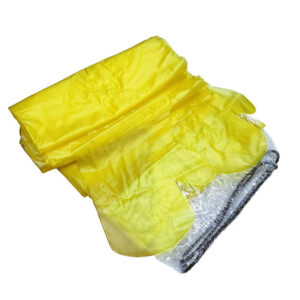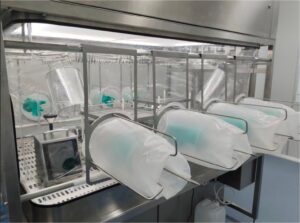في مشهد التصنيع التنافسي اليوم, مرشحات غرف التنظيف العالمية تمثل حلاً بالغ الأهمية للمنشآت التي تسعى إلى المرونة التشغيلية دون المساس بمعايير التحكم في التلوث. وسواء كنت تدير خط إنتاج أدوية أو منشأة تصنيع أشباه الموصلات أو مختبر تكنولوجيا حيوية، فإن التحدي المتمثل في الحفاظ على مواصفات متعددة للمرشحات مع التحكم في التكاليف أصبح معقدًا بشكل متزايد.
تمتد عواقب عدم توافق المرشحات إلى ما هو أبعد من مجرد مشاكل الشراء البسيطة. فغالبًا ما تواجه المرافق وقت تعطل طويل أثناء استبدال المرشحات، وتضخم تكاليف المخزون من المتطلبات الخاصة بالعلامة التجارية، ومخاطر التلوث المحتملة عندما تفشل البدائل الطارئة في تلبية المواصفات الدقيقة. كشفت دراسة استقصائية حديثة في الصناعة أن 73% من مديري غرف التنظيف يشيرون إلى أن مشكلات توافق المرشحات هي مصدر قلقهم الرئيسي في الصيانة.
يبحث هذا الدليل الشامل في كيفية فلاتر متوافقة مع علامات تجارية متعددة وأنظمة التحجيم الموحدة يمكن أن تبسط استراتيجية التحكم في التلوث لديك. سنستكشف الأسس التقنية للتوافق العالمي، وأطر الاختيار العملية، وأساليب التنفيذ الاستراتيجية التي تستخدمها المنشآت الرائدة لتحسين أنظمة الترشيح الخاصة بها مع الحفاظ على معايير النظافة الصارمة.
ما هي فلاتر هواء غرف الأبحاث العالمية؟
تمثل فلاتر هواء غرف الأبحاث العالمية نهجًا موحدًا للتحكم في التلوث، وهي مصممة للعمل عبر العديد من العلامات التجارية للمعدات وتكوينات النظام. على عكس المرشحات المملوكة التي تحصر المنشآت في علاقات مع بائع واحد، فإن هذه المرشحات فلاتر هواء قابلة للتبديل استخدام أبعاد ومواصفات أداء متوافقة مع معايير الصناعة لضمان توافق واسع النطاق.
YOUTH للتكنولوجيا النظيفة كانت رائدة في العديد من مبادئ التصميم التي تجعل التوافق العالمي ممكنًا، مع التركيز على دقة الأبعاد واتساق الأداء عبر التطبيقات المتنوعة.
مبادئ التصميم الأساسية
يرتكز أساس تصميم المرشح العالمي على ثلاثة عناصر حاسمة: أبعاد الإطار الموحدة وتكوينات الوسائط المتسقة وآليات الختم الموحدة. تحقق الشركات المصنعة للمرشحات التوافق من خلال الالتزام بمعايير الصناعة المعمول بها مثل مواصفات سلسلة IEST-RP-CC001 وسلسلة ISO 14644.
يستخدم بناء الإطار عادةً الألومنيوم المبثوق أو الفولاذ المجلفن مع تفاوتات دقيقة في الأبعاد تبلغ ± 1.5 مم. ويضمن هذا التفاوت الضيق الملاءمة المناسبة عبر مختلف الشركات المصنعة للمبيتات مع الحفاظ على السلامة الهيكلية اللازمة لتطبيقات الضغط العالي. تتبع هندسة طيّ الوسائط أنماطًا موحدة تعمل على تحسين توزيع تدفق الهواء بغض النظر عن تكوين المعدات النهائية.
ربما يمثل نظام منع التسرب عامل التوافق الأكثر أهمية. تستخدم المرشحات العالمية ملامح حشية موحدة ونسب ضغط موحدة تحافظ على أداء محكم الإغلاق مانع للتسرب عبر آليات التثبيت المختلفة. من خلال تجربتنا، أبلغت المنشآت التي تطبق استراتيجيات المرشحات العالمية عن انخفاض 40-60% في تعقيد مخزون المرشحات.
إطار التحجيم القياسي
| حجم المرشح | الأبعاد الاسمية (مم) | سعة تدفق الهواء (متر مكعب/ساعة) | التطبيقات النموذجية |
|---|---|---|---|
| 610×610×69 | 24″×24″×2.75″ | 1,700-2,100 | غرف التنظيف العامة |
| 610×610×150 | 24″×24″×6″ | 3,400-4,200 | المعالجة عالية الحجم |
| 305×610×69 | 12″×24″×2.75″ | 850-1,050 | الأنظمة المعيارية |
تعمل أطر التحجيم القياسية على التخلص من التخمين من اختيار المرشح مع ضمان خصائص أداء متسقة. تتماشى الأبعاد العالمية الأكثر شيوعًا مع معايير اختبار ASHRAE 52.2، مما يوفر بيانات أداء موثوقة تنتقل بين المنشآت.
لماذا تختار الفلاتر المتوافقة مع علامات تجارية متعددة؟
المزايا الاستراتيجية لـ فلاتر متوافقة مع علامات تجارية متعددة تتجاوز اعتبارات التكلفة البسيطة، وتشمل المرونة التشغيلية ومرونة سلسلة التوريد وكفاءة الصيانة على المدى الطويل. وعادة ما تحقق المرافق التي تطبق استراتيجيات الترشيح الشاملة تخفيضًا يتراوح بين 25 و351 تيرابايت و10 تيرابايت في إجمالي تكاليف الترشيح مع تحسين موثوقية النظام.
مزايا كفاءة التكلفة
تظهر المزايا الاقتصادية عبر مجالات تشغيلية متعددة. يسمح توحيد المخزون للمنشآت بالاحتفاظ بعدد أقل من وحدات حفظ المخزون مع تحقيق تغطية أوسع لاحتياجاتها من الترشيح. قامت إحدى المنشآت الصيدلانية التي قمنا بتحليلها بتخفيض مخزون المرشحات لديها من 47 رقم جزء مختلف إلى 12 تكوينًا عالميًا فقط، مما أدى إلى خفض تكاليف التخزين بمقدار 601 تيرابايت و10 أطنان.
يزداد نفوذ المشتريات بشكل كبير عندما لا تكون المرافق مقيدة بعلاقات مع مورد واحد. وتصبح المناقصات التنافسية ممكنة عبر قاعدة موردين أوسع، حيث تبلغ المنشآت عن تحقيق وفورات تتراوح بين 15 و10 أضعاف تكاليف اقتناء المرشحات. بالإضافة إلى ذلك، تنخفض تكاليف المشتريات الطارئة بشكل كبير عندما تكون البدائل المتوافقة متاحة بسهولة من مصادر متعددة.
تنشأ فرص الشراء بكميات كبيرة بشكل طبيعي من توحيد المخزون. فبدلاً من شراء كميات صغيرة من الفلاتر ذات العلامات التجارية المحددة، يمكن للمنشآت التفاوض على أسعار أفضل على كميات أكبر من التكوينات العالمية. تحدث نقطة التعادل عادةً في المنشآت التي تستخدم أكثر من 200 مرشح سنويًا.
المرونة التشغيلية
تصبح جدولة الصيانة أكثر قابلية للتنبؤ عندما يؤدي التوافق العالمي إلى التخلص من المهل الزمنية الخاصة بالبائعين. يمكن للمنشآت الحفاظ على مستويات المخزون المثلى دون التعرض لخطر التعطل الممتد بسبب عدم توفر المرشحات. وتثبت هذه المرونة قيمتها بشكل خاص خلال فترات ذروة الإنتاج أو عند إدارة منشآت متعددة بتكوينات معدات متنوعة.
يصبح تدريب موظفي الصيانة المتبادل أكثر بساطة عندما تظل إجراءات تركيب المرشحات متسقة عبر مختلف العلامات التجارية للمعدات. يقوم الفنيون بتطوير خبراتهم باستخدام طرق تركيب موحدة بدلاً من تعلم أنظمة متعددة مملوكة. يقلل هذا الاتساق من أخطاء التركيب ويحسن من كفاءة الصيانة الكلية.
كيف تعمل أنظمة فلاتر الهواء ذات الإسناد التبادلي؟
فلاتر الهواء المرجعية التبادلية تعمل على مبدأ التكافؤ في الأبعاد والأداء بين مواصفات الشركات المصنعة المختلفة. وتتضمن العملية رسم خرائط مفصلة لخصائص المرشح لوضع بروتوكولات استبدال موثوقة تحافظ على فعالية التحكم في التلوث.
يتطلب فهم هذه الأنظمة الإلمام بكل من عوامل التوافق الميكانيكي وطرق التحقق من الأداء. بينما توفر مطابقة الأبعاد الأساس، فإن ارتباط الأداء يضمن أن البدائل تحافظ على كفاءة الترشيح المطلوبة وخصائص تدفق الهواء.
معايير توافق الأبعاد
يبدأ التوافق المادي بالمطابقة الدقيقة لأبعاد الإطار، بما في ذلك الأبعاد الخارجية ومواصفات أخدود الحشية وأنماط فتحات التركيب. تشمل القياسات الأكثر أهمية الطول الكلي والعرض والعمق، والتي يتم الحفاظ عليها عادةً في حدود ± 1 مم من أجل إحكام الإغلاق المناسب.
يجب أن تتماشى تكوينات الحشية بدقة لضمان أداء محكم مانع للتسرب. تستخدم المرشحات العالمية تشكيلات حشية موحدة تضغط باستمرار عبر أنظمة التثبيت المختلفة. وتتراوح نسبة الضغط عادةً بين 20-25% من سُمك الحشية الأصلي، مما يوفر إحكامًا موثوقًا دون ضغط زائد قد يتسبب في حدوث عطل سابق لأوانه.
تتطلب هياكل دعم الوسائط الداخلية التوافق مع أنماط تدفق الهواء الحالية. يجب أن تحافظ مسافات الطيات، وهندسة شبكة الدعم، وتكوينات الواجهات النهائية على توزيع هواء متناسق لمنع التجاوزات أو عدم انتظام الضغط. ويمتد هذا التوافق إلى وصلات مجاري الهواء في المنبع والمصب.
بروتوكولات مطابقة الأداء
| المعلمة | نطاق التحمل | طريقة التحقق | التأثير على التوافق |
|---|---|---|---|
| الكفاءة عند 0.3 ميكرومتر | ±2% | اختبار MPPS | عالية |
| انخفاض الضغط الأولي | ± 10 باسكال | قياس منضدة التدفق | متوسط |
| سعة الاحتفاظ بالغبار | ±15% | تحميل الغبار الاصطناعي | منخفضة |
يضمن التحقق من الأداء أن توافق الأبعاد يُترجم إلى تكافؤ تشغيلي. يجب أن تحافظ مرشحات HEPA على كفاءة 99.97% كحد أدنى عند 0.3 ميكرون من الجسيمات، بينما تتطلب مواصفات ULPA كفاءة 99.9995%. تظل معايير الأداء هذه غير قابلة للتفاوض بغض النظر عن توافق الأبعاد.
يجب أن تتوافق خصائص انخفاض الضغط ضمن نطاقات مقبولة لمنع اختلال توازن النظام. تم تصميم المرشحات العالمية لتتناسب مع خصائص انخفاض الضغط لمواصفات المعدات الأصلية، وعادةً ما تحافظ على الاتساق في حدود ± 10 باسكال في ظل ظروف تدفق الهواء القياسية.
ما الذي يجعل فلاتر غرف الأبحاث ذات الحجم القياسي عالمية؟
عالمية مرشحات غرف الأبحاث ذات الحجم القياسي ينبع من اعتماد مواصفات الأبعاد ومعايير الأداء المشتركة على مستوى الصناعة. وقد انبثق هذا التوحيد القياسي من الجهود التعاونية بين مصنعي المعدات والمستخدمين النهائيين وأخصائيي الترشيح للحد من التعقيد مع الحفاظ على معايير الأداء.
توحيد معايير الصناعة
وضعت منظمات المعايير الدولية مواصفات شاملة تحدد معايير التوافق العالمي. وتحدد المبادئ التوجيهية لمعهد العلوم والتكنولوجيا البيئية (IEST) تفاوتات الأبعاد، بينما تحدد معايير ISO 14644 متطلبات الأداء التي تضمن فعالية متسقة في مكافحة التلوث.
ويعتمد اتساق التصنيع بين الموردين المختلفين على الالتزام بهذه المعايير المحددة. وتتحقق بروتوكولات مراقبة الجودة من دقة الأبعاد وخصائص الأداء من خلال طرق اختبار موحدة. ووفقًا لبيانات الصناعة، تحقق المنشآت التي تستخدم مرشحات عالمية معتمدة معدلات توافق 99.2% مع المعدات الحالية.
يستمر معدل اعتماد المعايير العالمية في التسارع، حيث أن ما يقرب من 78% من منشآت غرف الأبحاث الجديدة تحدد تكوينات ذات حجم قياسي. يعكس هذا الاتجاه إدراكًا متزايدًا للفوائد التشغيلية والاقتصادية المرتبطة بالنهج الموحدة.
تفاوتات التصنيع
تمكّن تقنيات التصنيع الدقيقة من تحقيق التفاوتات الدقيقة اللازمة للتوافق العالمي. ويضمن التصنيع الآلي باستخدام الحاسب الآلي لإطارات المرشحات اتساق الأبعاد في حدود ± 0.5 مم، بينما تحافظ عمليات التجميع الآلية على اتساق وضع الحشية وخصائص الضغط.
تشمل بروتوكولات ضمان الجودة التحقق من أبعاد 100% وأخذ عينات إحصائية لخصائص الأداء. يضمن اختبار الدفعات أن كل عملية إنتاج تفي بالمواصفات اللازمة للتوافق العالمي. يمثل هذا المستوى من مراقبة الجودة استثمارًا كبيرًا ولكنه يثبت أنه ضروري للحفاظ على الموثوقية التي تتطلبها الأنظمة العالمية.
كيف تختار حلول دليل التصفية المتوافقة؟
اختيار المناسب دليل الفلتر المتوافق تتطلب الحلول تقييماً منهجياً لكل من المتطلبات التقنية والقيود التشغيلية. وتتضمن عملية الاختيار تحليلاً مفصلاً لمواصفات النظام الحالي ومتطلبات الأداء واستراتيجيات الصيانة طويلة الأجل.
ويعتمد التنفيذ الناجح على التحقق الشامل من التوافق والتحقق من صحة الأداء قبل الالتزام باستراتيجيات المرشحات العالمية. وفي حين أن الفوائد كبيرة، إلا أن العناية الواجبة المناسبة تمنع حدوث مشاكل التوافق التي يمكن أن تضر بفعالية مكافحة التلوث.
إطار التقييم
يبدأ التقييم الأولي بالتوثيق الشامل لمواصفات المرشح الحالي في جميع الأنظمة ذات الصلة. وينبغي أن يتضمن هذا الجرد قياسات الأبعاد، وتصنيفات الأداء، وأي متطلبات فريدة للتركيب أو الختم يمكن أن تؤثر على التوافق العالمي.
يحدد تحليل تدفق هواء النظام ما إذا كانت البدائل العالمية يمكنها الحفاظ على مستويات الأداء المطلوبة. يجب أن تراعي حسابات انخفاض الضغط أي اختلافات في مقاومة الوسائط أو هندسة الإطار. من واقع خبرتنا، يمكن أن تستوعب 85% من التركيبات الحالية البدائل العالمية دون تعديلات في النظام.
يجب أن يشمل تحليل التكاليف والفوائد كلاً من الوفورات الفورية في المشتريات والكفاءات التشغيلية طويلة الأجل. وتتراوح فترة استرداد التكاليف لتنفيذ الفلتر الشامل عادةً بين 12-18 شهراً، حسب حجم المنشأة وتعقيد المخزون الحالي.
التحقق من الأداء
يتحقق اختبار ما قبل التنفيذ من أن البدائل العالمية تفي بمعايير الأداء الحالية أو تتجاوزها. وينبغي أن يشمل هذا الاختبار التحقق من الكفاءة وقياس انخفاض الضغط وتقييم السلامة الهيكلية في ظل الظروف التشغيلية.
توفر التجارب الميدانية رؤى قيمة حول التوافق والأداء في العالم الحقيقي. يسمح نهج التنفيذ المرحلي للمنشآت بالتحقق من أداء المرشح الشامل في التطبيقات الأقل أهمية قبل التوسع إلى بيئات أكثر تطلبًا. حلول الترشيح عالية الكفاءة المصممة للتوافق العالمي غالباً ما تتجاوز مواصفات أداء المعدات الأصلية.
ما هي تحديات التنفيذ؟
في حين أن مرشحات غرف التنظيف العالمية مزايا كبيرة، إلا أن التنفيذ ينطوي على العديد من التحديات التي تتطلب إدارة دقيقة. ويتيح فهم هذه القيود تحسين التخطيط واستراتيجيات التخفيف من المخاطر.
اختلافات الجودة
يمثل اتساق جودة الموردين التحدي الرئيسي في تنفيذ المرشح العالمي. فبينما تضمن معايير الأبعاد التوافق المادي، يمكن أن تختلف جودة الأداء بين الشركات المصنعة. ويساعد وضع قوائم الموردين المؤهلين وتنفيذ بروتوكولات التفتيش الواردة في الحفاظ على معايير الأداء.
يصبح التحقق من الأداء أكثر تعقيدًا عند إدارة العديد من الموردين لنفس مواصفات المرشح. قد يحقق كل مورد الأداء المطلوب من خلال تكوينات وسائط أو طرق بناء مختلفة، مما قد يؤدي إلى اختلافات دقيقة في الأداء تؤثر على الموثوقية على المدى الطويل.
اعتبارات الضمان
قد تقوم الشركات المصنعة للمعدات الأصلية بإبطال الضمانات عند تركيب فلاتر غير مصنعة من قبل الشركات المصنعة للمعدات الأصلية، مما يخلق مخاوف محتملة بشأن المسؤولية. تساعد المراجعة القانونية لشروط الضمان واتفاقيات الصيانة على تحديد التعارضات المحتملة قبل التنفيذ. تعالج العديد من المنشآت هذا القلق من خلال ضمانات الأداء من موردي المرشحات العالمية.
أين يمكنك الحصول على فلاتر غرف الأبحاث العالمية؟
يتطلب توفير مصادر موثوقة لمرشحات غرف الأبحاث العالمية شراكات مع الشركات المصنعة التي تثبت قدرات ثابتة للجودة والدعم الفني. يوفر الموردون الرائدون قواعد بيانات شاملة للتوافق والوثائق الفنية وضمانات الأداء التي تدعم التنفيذ الناجح.
تنطوي استراتيجيات التوريد الأكثر فعالية على تطوير علاقات مع العديد من الموردين المؤهلين مع الحفاظ على معايير أداء متسقة. ويوفر هذا النهج مرونة في سلسلة التوريد مع ضمان الأسعار التنافسية والتوافر الموثوق به.
مرشحات غرف الأبحاث العالمية تمثل نهجًا استراتيجيًا للتحكم في التلوث يوازن بين متطلبات الأداء والكفاءة التشغيلية. ومن خلال الاختيار والتنفيذ الدقيقين، يمكن للمنشآت تحقيق وفورات كبيرة في التكاليف مع الحفاظ على معايير النظافة الصارمة التي تتطلبها عملياتها.
ويكمن مفتاح النجاح في التحقق الشامل من التوافق، والتحقق المنهجي من صحة الأداء، والإدارة المستمرة للجودة. وعلى الرغم من وجود تحديات في التنفيذ، فإن فوائد تقليل التعقيد وتحسين المرونة وانخفاض التكاليف الإجمالية تجعل استراتيجيات المرشحات العالمية جذابة بشكل متزايد للمنشآت ذات التفكير المستقبلي.
مع استمرار تطور التوحيد القياسي في الصناعة، سيصبح التوافق العالمي هو القاعدة المتوقعة بدلاً من النهج البديل. المنشآت التي تتبنى تقنيات الترشيح التي أثبتت جدارتها والممارسات الموحدة لتحقيق النجاح التشغيلي على المدى الطويل مع الحفاظ على فعالية مكافحة التلوث التي تتطلبها عملياتها الحرجة.
الأسئلة الشائعة
Q: ما هي فلاتر هواء غرف الأبحاث العالمية ولماذا هي مهمة؟
ج: فلاتر هواء غرف الأبحاث العالمية هي فلاتر مصممة خصيصًا ومتوافقة مع العديد من العلامات التجارية وأنظمة غرف الأبحاث. وهي تلعب دورًا حاسمًا في الحفاظ على نقاء الهواء المطلوب في البيئات الخاضعة للرقابة مثل مختبرات الأدوية وتصنيع الإلكترونيات والرعاية الصحية. يعمل توافقها متعدد العلامات التجارية على تبسيط استبدال المرشحات وتقليل وقت التوقف عن العمل وخفض التكاليف من خلال السماح للمنشآت باستخدام مرشحات موحدة بدلاً من المرشحات الخاصة بالعلامة التجارية. تضمن هذه المرشحات الإزالة الفعالة للجسيمات والملوثات المحمولة في الهواء لتلبية المعايير الصارمة لغرف التنظيف.
Q: كيف تختلف مرشحات هواء غرف الأبحاث العالمية عن المرشحات الخاصة بالعلامة التجارية؟
ج: على عكس المرشحات الخاصة بالعلامة التجارية المصممة خصيصًا لتناسب طرازات معينة فقط، تم تصميم مرشحات هواء غرف الأبحاث العالمية لتناسب مجموعة من الأنظمة من مختلف الشركات المصنعة. يتم تحقيق هذه القدرة على التكيف من خلال ميزات التحجيم والتصميم القياسية التي تتناسب مع علب المرشحات الشائعة. تشمل مزايا المرشحات العالمية سهولة إدارة المخزون والمرونة في الشراء وأسعارًا أكثر تنافسية في كثير من الأحيان. وهي تحافظ على نفس أداء الترشيح عالي الكفاءة مثل فلاتر الشركة المصنعة الأصلية، مما يضمن عدم وجود أي تنازلات في جودة هواء غرف الأبحاث.
Q: ما هي العوامل التي يجب مراعاتها عند اختيار مرشحات هواء غرف الأبحاث العالمية؟
ج: عند اختيار مرشحات هواء غرف الأبحاث العامة، ضع في اعتبارك العوامل التالية:
- كفاءة التصفية: اختر من بين مرشحات HEPA أو ULPA بناءً على فئة غرفتك النظيفة ومتطلبات حجم الجسيمات.
- التوافق: تأكد من تطابق أبعاد الفلتر ونوع الإطار مع مبيت الفلتر الموجود لديك.
- جودة المواد: ابحث عن الهيكل المتين مثل الألومنيوم أو إطارات الفولاذ المقاوم للصدأ لضمان المتانة.
- سهولة الاستبدال: ضع في اعتبارك تصميمات المرشحات التي تسمح بالاستبدال من جانب الغرفة لتقليل وقت التعطل والمخاطر.
- التصديق: تأكد من أن الفلتر يفي بمعايير غرف الأبحاث ذات الصلة (تصنيفات ISO).
Q: هل يمكن لمرشحات هواء غرف الأبحاث العالمية الحفاظ على نفس معايير جودة الهواء مثل المرشحات الأصلية؟
ج: نعم، تم تصميم مرشحات هواء غرف الأبحاث العالمية لتلبية معايير جودة الهواء لمرشحات الشركة المصنعة للمعدات الأصلية (OEM) أو تجاوزها. وهي تستخدم وسائط ترشيح عالية الكفاءة مثل HEPA أو ULPA المصنفة لالتقاط الجسيمات المجهرية حتى 0.3 ميكرون أو أصغر. وتخضع هذه الفلاتر لاختبارات صارمة لمقاومة تدفق الهواء واختراق الجسيمات لضمان الامتثال لتصنيفات ISO لغرف الأبحاث. توفر الفلاتر العامة المختارة بشكل صحيح تحكمًا موثوقًا في الجسيمات دون المساس بأداء غرف الأبحاث.
Q: كيف يفيد التوافق متعدد العلامات التجارية عمليات غرف التنظيف؟
ج: يوفر التوافق متعدد العلامات التجارية العديد من المزايا التشغيلية:
- تبسيط عملية الجرد: يمكن للمنشآت تخزين أنواع أقل من الفلاتر، مما يقلل من التعقيد واحتياجات التخزين.
- كفاءة التكلفة: يمكن للمنافسة بين موردي المرشحات المتوافقة أن تخفض تكاليف الشراء.
- صيانة أسرع: توفر الفلاتر الشاملة يعني استبدال أسرع ووقت تعطل أقل.
- المرونة: سهولة الحصول على المصادر أثناء تعطل سلسلة التوريد أو عند التبديل معدات غرف الأبحاث العلامات التجارية.
وفي النهاية، يعمل التوافق متعدد العلامات التجارية على تبسيط صيانة غرف التنظيف مع ضمان اتساق معايير تنقية الهواء.
Q: ما هي نصائح الصيانة التي تعمل على تحسين أداء مرشحات هواء غرف التنظيف العالمية؟
ج: لزيادة عمر الفلتر وأدائه إلى أقصى حد:
- جدولة عمليات الفحص المنتظمة للتحقق من عدم وجود تلف مادي أو انسداد.
- استبدل الفلاتر وفقًا للجداول الزمنية لبروتوكول الشركة المصنعة أو بروتوكول غرف التنظيف، أو قبل ذلك إذا انخفض تدفق الهواء.
- استخدم مرشحات قابلة للاستبدال من جانب الغرفة إن أمكن لتقليل مخاطر التلوث أثناء التغييرات.
- مراقبة عدد الجسيمات في غرف التنظيف للتحقق من فعالية الترشيح.
- تأكد من التركيب المناسب مع إحكام غلق مانع التسرب لمنع الهواء الجانبي.
يساعد اتباع هذه الممارسات في الحفاظ على الظروف المثلى لغرف التنظيف باستخدام مرشحات هواء غرف التنظيف العالمية.
الموارد الخارجية
- فلاتر غرف التنظيف العالمية | خيارات الاستبدال المتوافقة - يستكشف هذا الدليل الحلول العملية لمرشحات غرف الأبحاث العالمية، ويقدم نظرة ثاقبة لخيارات الاستبدال المتوافقة للبيئات متعددة العلامات التجارية.
- الدليل النهائي لمرشحات HEPA وULPA - Terra Universal - تفاصيل فئات مرشحات HEPA وULPA، والبناء، وعوامل الشكل، مع تسليط الضوء على وسائط المرشح القابلة للتبديل واعتبارات التوافق لأنظمة غرف الأبحاث.
- مقارنة ميزات فلتر مروحة غرف الأبحاث - Terra Universal - يوفر مقارنة شاملة لوحدات فلتر المروحة، بما في ذلك تصميمات استبدال الفلاتر والتوافق مع مختلف خيارات فلتر HEPA وULPA.
- مخطط توافق فلتر علم الهواء - مستودع المختبر - The Lab Depot - يقدم لمحة عامة عن توافق المرشحات لوحدات شفاطات Air Science بدون مجاري هواء، مما يساعد المستخدمين على اختيار مرشحات غرف الأبحاث المناسبة العالمية أو المتوافقة مع العلامة التجارية.
- معدات الغرف النظيفة الهوائية SMC (PDF) - يتضمن هذا المستند سلسلة مرشحات الهواء النظيف لتطبيقات غرف الأبحاث، مع تفاصيل التوافق ومعلومات فئة ISO لتوجيه اختيار مرشح عبر العلامة التجارية.
- حلول فلتر هواء غرف الأبحاث - تقنية غرف الأبحاث - يناقش عوامل اختيار مرشحات HEPA وULPA، مع التركيز على قابلية التبادل والتوافق في إعدادات غرف التنظيف متعددة العلامات التجارية.
المحتويات ذات الصلة:
- فلاتر غرف التنظيف العالمية | خيارات الاستبدال المتوافقة
- مقارنة بين معدات غرف الأبحاث العامة مقابل معدات غرف الأبحاث ذات العلامة التجارية
- فلاتر HEPA العامة مقابل اسم العلامة التجارية | بدائل فعالة من حيث التكلفة
- فلاتر هواء متوافقة مع ممارسات التصنيع الجيدة | متطلبات إدارة الأغذية والعقاقير (FDA) التحقق من صحة غرف الأبحاث
- بدائل فلتر HEPA العامة | حلول متوافقة مع العلامة التجارية
- أنظمة فلاتر HEPA | مواصفات معدات مناولة الهواء
- فهم معايير جودة هواء غرف الأبحاث | متطلبات المرشح
- مقاييس أداء مرشح هواء غرف الأبحاث | المواصفات الفنية
- كفاءة فلتر HEPA: زيادة تنقية الهواء إلى أقصى حد




























